What Are the Natural Predators of Parrots in the Wild?
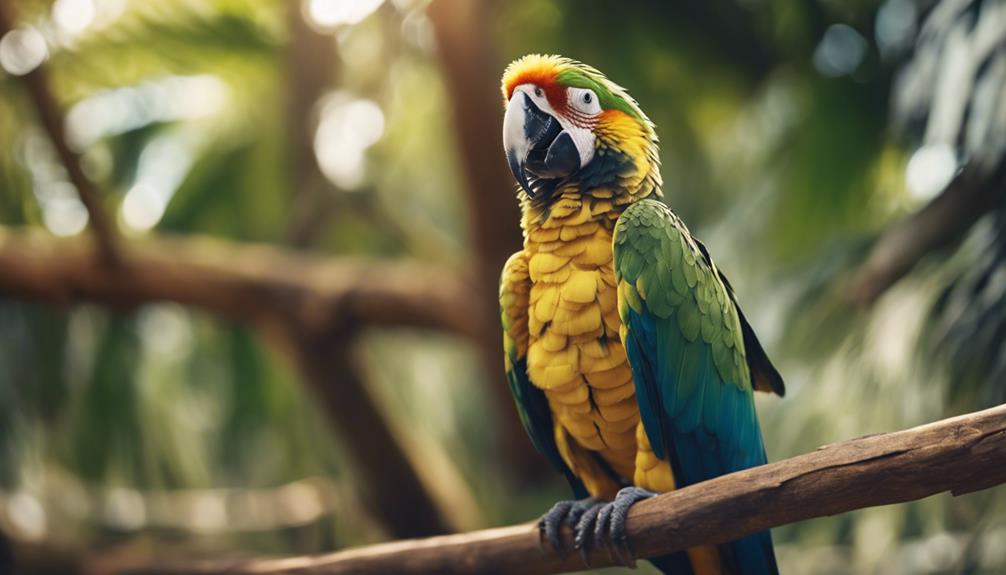
Natural predators of parrots in the wild include snakes, birds of prey, and mammals like monkeys and cats.
Parrots have evolved various strategies such as camouflage, speed, and flocking behavior to evade these predators and ensure their survival.
Snakes
Snakes play a crucial role as natural predators of parrots in the wild, utilizing their stealth and venom to capture their avian prey. Snake behavior is characterized by patience and precision when hunting. They rely on their keen sense of smell to track down potential prey, often waiting in strategic locations for extended periods. Once they spot a parrot, snakes use their agility and lightning-fast strike to overpower the bird before injecting venom to incapacitate it.
In response to the constant threat posed by snakes, parrots have developed various prey adaptations. These adaptations include heightened awareness of their surroundings, enabling them to detect the presence of snakes through visual and auditory cues. Additionally, parrots have evolved quick reflexes and the ability to take flight rapidly when they sense danger, allowing them to escape from snake attacks. Despite these adaptations, the interaction between snakes and parrots remains a critical aspect of the delicate balance in the wild.
Birds of Prey
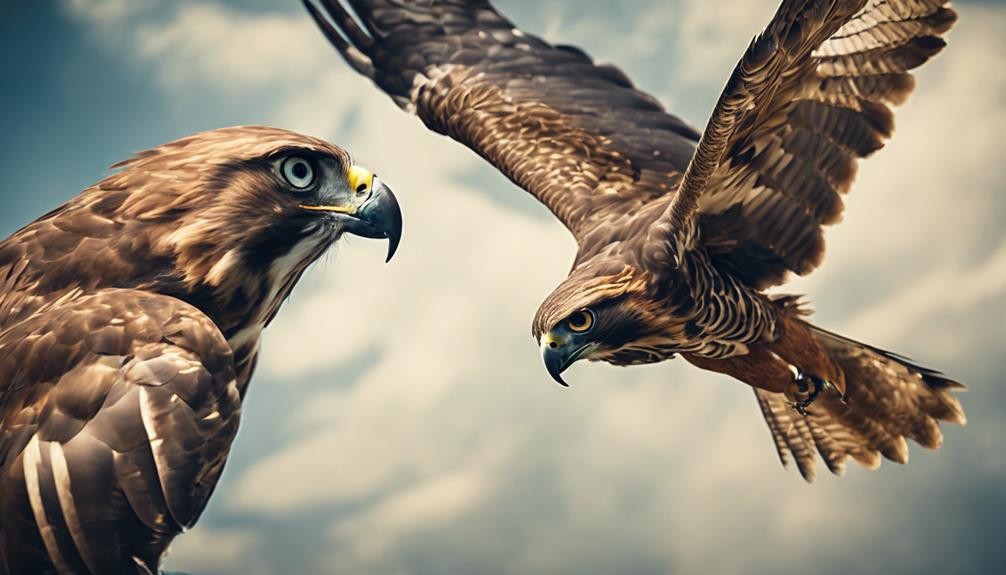
In the intricate ecosystem of the wild, Birds of Prey occupy a significant position as natural predators of parrots, showcasing their aerial prowess and hunting skills. Predatory eagles and falcons are among the most formidable avian threats to parrots, posing a constant danger to these colorful birds. Birds of Prey have keen eyesight and powerful talons, enabling them to spot and capture unsuspecting parrots with remarkable precision.
Eagles, with their impressive wingspans and sharp beaks, are particularly skilled at hunting parrots both in flight and while perched in trees. Falcons, known for their incredible speed and agility, can swiftly dive down to ambush parrots with swift and deadly accuracy. These predators play a crucial role in maintaining the balance of the ecosystem by controlling parrot populations and ensuring the survival of other species.
Parrots have developed various defensive mechanisms to evade these skilled hunters, including alarm calls, flocking behaviors, and seeking shelter in dense vegetation. Despite these strategies, the presence of Birds of Prey remains a constant threat in the natural world.
Monkeys
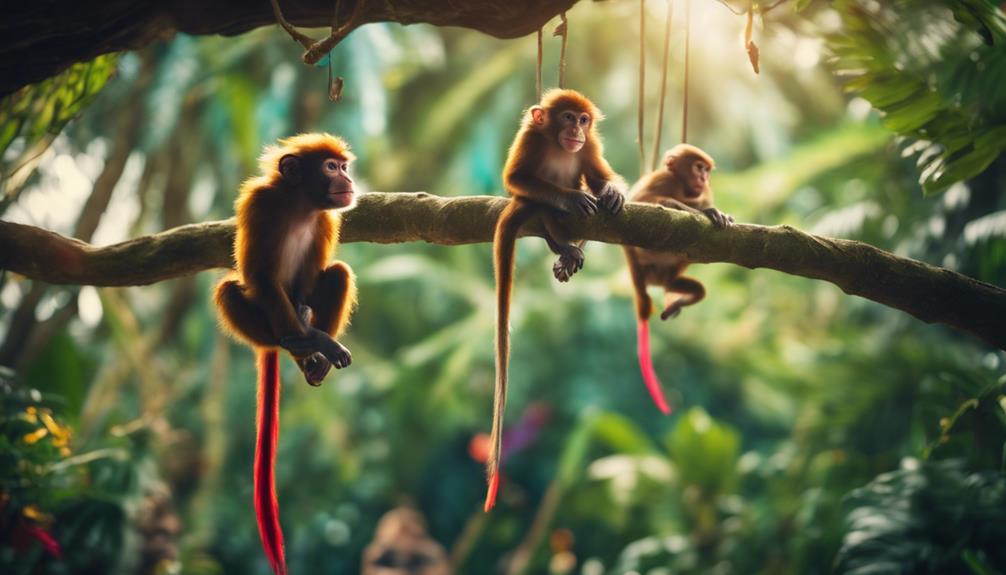
Monkeys, particularly species like capuchins and macaques, are known to prey on parrots in the wild. Their agile nature and sharp claws allow them to navigate through the dense foliage where parrots often reside, making them efficient hunters.
The impact of monkey predation on parrot populations can be significant, especially in areas where these primates have easy access to parrot habitats.
Monkey Predation
Among the various natural predators of parrots in the wild, monkeys are known to pose a threat due to their agile nature and ability to navigate the treetops where parrots often reside. Monkeys exhibit behavioral adaptations such as keen intelligence and nimbleness, enabling them to hunt parrots efficiently. Their interactions with parrots are often characterized by stealth and quick strikes.
In terms of ecological significance, monkey predation plays a role in predator-prey dynamics, helping regulate parrot populations and contributing to the overall balance of the ecosystem. Understanding the dynamics of monkey predation on parrots is crucial for conservation efforts aimed at protecting these colorful birds from natural threats in their habitats.
Impact on Parrots
Given their adeptness in navigating treetops where parrots often reside, monkeys' impact on parrots in the wild extends beyond mere predation to influence various aspects of the parrots' behavior and habitat utilization. Predator-prey relationships play a crucial role in ecosystem dynamics, shaping the distribution and behavior of both species.
Monkeys, as predators of parrots, can induce behavioral changes in parrots, causing them to alter their foraging patterns, communication methods, and nesting habits to avoid predation. This constant pressure from monkeys as predators can lead to a cascade effect within the ecosystem, affecting not only the parrot population but also the vegetation and other species they interact with.
Understanding these intricate relationships is essential for conserving the delicate balance of the ecosystem and ensuring the survival of parrot populations in the wild.
Wild Cats
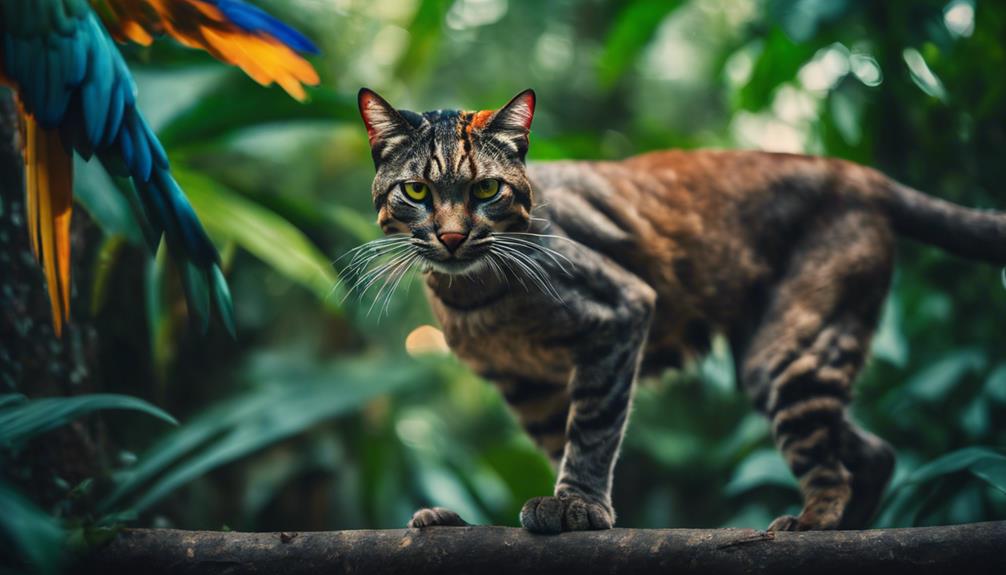
Wild cats, such as jaguars and ocelots, pose a significant threat to parrot populations in the wild. Their stealth and agility make them formidable hunters, capable of ambushing unsuspecting parrots.
The impact of wild cats on parrot populations underscores the complex predator-prey dynamics in natural ecosystems.
Feline Threats
Felines, particularly wild cats, pose a significant threat to parrots in their natural habitats. Wild cats exhibit stealthy behavior and exceptional hunting skills honed for survival.
Parrots, on the other hand, rely on their vibrant plumage as a form of camouflage to blend into their surroundings and avoid detection by predators. Despite their colorful appearance, parrots have also evolved various adaptations to evade feline threats. Their keen eyesight and agile flying abilities allow them to swiftly escape from prowling felines.
However, the element of surprise and the cat's predatory instincts make them formidable adversaries for parrots. Understanding the interplay between feline behavior and parrot adaptation is crucial in appreciating the complex predator-prey dynamics in the wild.
Hunting Techniques
Parrots in the wild face formidable challenges due to the hunting techniques employed by wild cats, which are finely tuned for capturing prey with stealth and precision. Wild cats pose a significant threat to parrots through their:
- Camouflage Skills: Wild cats use their natural camouflage to blend seamlessly into their surroundings, making it easier to stalk unsuspecting prey like parrots.
- Ambush Tactics: These feline predators are experts at ambush tactics, patiently waiting for the perfect moment to strike and catch their avian targets off guard.
- Silent Movements: Wild cats move silently and swiftly, allowing them to approach parrots without raising any alarm, increasing their hunting success rate significantly.
These specialized hunting techniques make wild cats formidable predators in the wild, putting parrots at risk of predation.
Impact on Parrot Population
The presence of adept predators in the form of wild cats has a discernible impact on the parrot population in their natural habitats. Population dynamics of parrots are significantly influenced by environmental factors such as predation by wild cats. The pressure exerted by these feline predators can lead to fluctuations in parrot numbers, impacting the overall population health.
Conservation efforts play a crucial role in mitigating the effects of wild cat predation on parrot populations. Habitat protection is vital to provide safe spaces for parrots to thrive without the constant threat of predation. By understanding the relationship between wild cats and parrots, conservationists can implement strategies to safeguard parrot populations and ensure their long-term survival in the face of natural predators.
Raptors
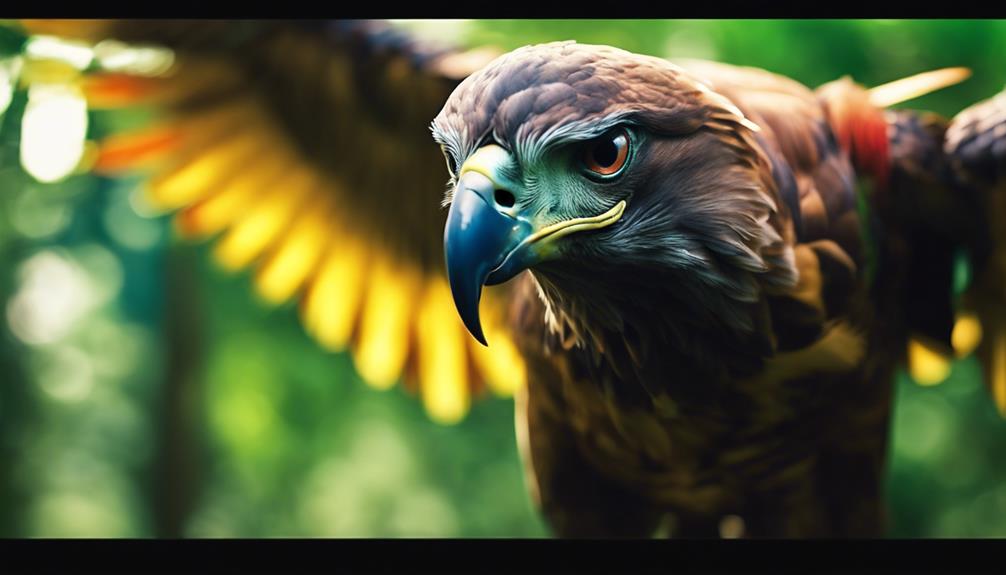
Raptors, formidable predators in the avian world, play a crucial role in the natural ecosystem by hunting smaller birds, including parrots, for sustenance. These birds of prey exhibit remarkable predatory behavior and hunting patterns, making them efficient hunters.
Here are some key points about raptors:
- Nest Defense: Raptors are known for their ability to locate and attack bird nests to procure food not only for themselves but also for their offspring.
- Survival Strategies: They employ various survival strategies such as stealth, agility, and sharp talons to capture their prey, which may include parrots living in the wild.
- Predatory Behavior: With keen eyesight and powerful beaks, raptors swiftly swoop down on unsuspecting birds, displaying their prowess as top predators in the avian food chain.
Raptors serve as a natural control mechanism in the ecosystem, regulating bird populations and contributing to the balance of nature through their hunting activities.
Carnivorous Mammals
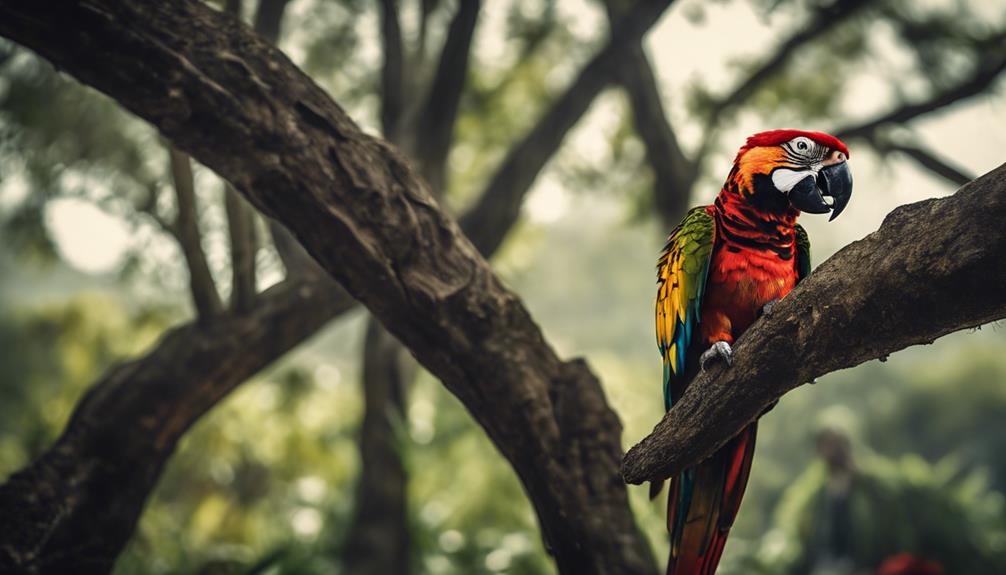
In the wild, carnivorous mammals, equipped with sharp teeth and keen senses, play a significant role in the ecosystem as efficient predators of various small animals, including parrots. These mammals exhibit diverse dietary preferences, with some specializing in hunting birds like parrots. The ecological role of carnivorous mammals in parrot predation influences population dynamics and ecosystem balance.
Survival strategies of carnivorous mammals are finely tuned to capture avian prey. They often rely on stealth, speed, and ambush techniques to catch parrots unaware. Additionally, these predators possess adaptations such as strong jaw muscles and sharp claws that aid in subduing their feathered targets efficiently.
Population dynamics within parrot communities are intricately linked to the presence of carnivorous mammals. The pressure exerted by these predators can limit parrot numbers in specific regions, impacting the overall distribution and abundance of these colorful birds. Understanding the interactions between carnivorous mammals and parrots is crucial for conservation efforts aimed at protecting these avian species from predation pressures.
Reptiles
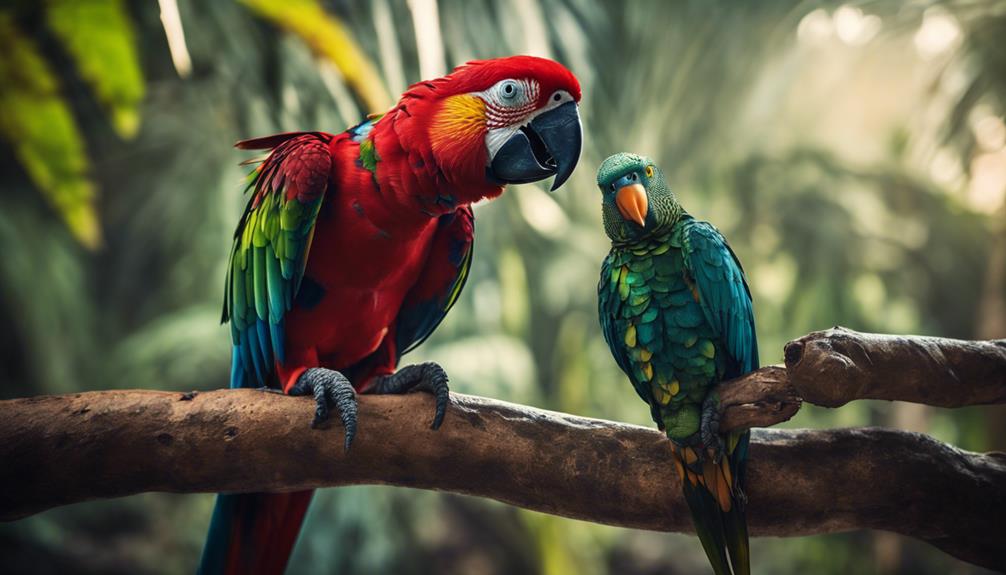
Camouflaged among foliage or basking on sun-soaked branches, reptiles stealthily stalk their avian prey in the wild, demonstrating specialized hunting techniques. In the intricate dance of predator versus prey, reptiles play a crucial role in the natural ecosystem. Here are some fascinating insights into how reptiles interact with parrots:
- Habitat threats: The encroachment of human activities like deforestation and urbanization poses significant threats to the natural habitats of reptiles, affecting their hunting grounds and potentially disrupting the delicate balance of predator-prey relationships.
- Survival strategies: To adapt to changing environments, reptiles have developed various survival strategies such as altering their hunting patterns, seeking out new territories, and adjusting their diets to ensure their own survival and that of their prey.
- Prey adaptations: Parrots, as potential prey for reptiles, have evolved intricate camouflage techniques, mimicry abilities, and heightened senses to evade detection and enhance their chances of survival in the face of reptilian predators.
Understanding these dynamics sheds light on the complex interplay between reptiles and parrots, highlighting the importance of predator avoidance and prey adaptations in the wild.
Frequently Asked Questions
What Are Some Adaptations Parrots Have Developed to Defend Themselves Against Predators?
Parrots have developed remarkable adaptations to defend against predators. They employ camouflage techniques to blend in with their surroundings, use alarm calls to alert others, mimicry behavior to confuse foes, and engage in mobbing behavior to intimidate threats.
Do Parrots Have Any Behavioral Strategies to Avoid Being Hunted by Predators?
In the lush rainforest, parrots master the art of avoiding detection through their intricate camouflage techniques. These colorful avians blend seamlessly with their surroundings, evading predators with stealth and cunning.
How Do Parrots Communicate With Each Other About Potential Threats From Predators?
Parrots communicate with vocal warnings and visual cues to alert each other about potential threats from predators. They use group alarm signals and warning calls to swiftly convey danger, ensuring the safety of the flock.
Are There Any Specific Regions or Habitats Where Parrots Are More Vulnerable to Predation?
In certain regions, parrots face heightened predation risks due to habitat vulnerabilities. Predation hotspots can be found where habitat fragmentation or destruction occur, making parrots more vulnerable to natural predators in these areas.
What Impact Do Human Activities, Such as Deforestation, Have on the Vulnerability of Parrots to Predators in the Wild?
Human activities such as deforestation disrupt the ecological balance, making parrots more vulnerable to predators in the wild. Conservation efforts are crucial to mitigate these impacts and protect these birds from increased predation risks.











